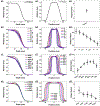Commissioning an ultra-high-dose-rate electron linac with end-to-end tests
- PMID: 39084661
- PMCID: PMC12152580
- DOI: 10.1088/1361-6560/ad69fc
Commissioning an ultra-high-dose-rate electron linac with end-to-end tests
Abstract
Objective. The FLASH effect can potentially be used to improve the therapeutic ratio of radiotherapy (RT) through delivery of Ultra-high-dose-rate (UHDR) irradiation. Research is actively being conducted to translate UHDR-RT and for this purpose the Mobetron is capable of producing electron beams at both UHDR and conventional dose rates for FLASH research and translation. This work presents commissioning of an UHDR Mobetron with end-to-end tests developed for preclinical research.Approach. UHDR electron beams were commissioned with an efficient approach utilizing a 3D-printed water tank and film to fully characterize beam characteristics and dependences on field size, pulse width (PW) and pulse repetition frequency (PRF). This commissioning data was used to implement a beam model using the GAMOS Monte Carlo toolkit for the preclinical research. Then, the workflow for preclinical FLASH irradiation was validated with end-to-end tests delivered to a 3D-printed mouse phantom with internal inhomogeneities.Main results.PDDs, profiles and output factors acquired with radiochromic films were precisely measured, with a PRF that showed little effect on the UHDR beam energy and spatial characteristics. Increasing PW reduced theDmaxand R50by 2.08 mmµs-1and 1.28 mmµs-1respectively. An end-to-end test of the preclinical research workflow showed that both profiles in head-foot and lateral directions were in good agreement with the MC calculations for the heterogeneous 3D printed mouse phantom with Gamma index above 93% for 2 mm/2% criteria, and 99% for 3 mm/3%.Significance. The UHDR Mobetron is a versatile tool for FLASH preclinical research and this comprehensive beam model and workflow was validated to meet the requirements for conducting translational FLASH research.
Keywords: FLASH; Mobetron; commissioning; electron; end-to-end test; ultra-high dose rate.
© 2024 Institute of Physics and Engineering in Medicine.
Conflict of interest statement
Conflict of interest
The authors have no relevant conflicts of interest to disclose.
Figures






References
-
- Agostinelli S et al. 2003. Geant4—a simulation toolkit Nucl. Instrum. Methods Phys. Res. A 506 250–303
-
- Arce P et al. 2014. Gamos: a framework to do Geant4 simulations in different physics fields with an user-friendly interface Nucl. Instrum. Methods Phys. Res. A 735 304–13
-
- Ashraf MR et al. 2023. Multi-institutional audit of FLASH and conventional dosimetry with a 3D-Printed anatomically realistic mouse phantom (arXiv:2309.16836) - PubMed
-
- Bohlen TT, Germond JF, Bourhis J, Vozenin MC, Ozsahin EM, Bochud F, Bailat C and Moeckli R 2022. Normal tissue sparing by FLASH as a function of single-fraction dose: a quantitative analysis Int. J. Radiat. Oncol. Biol. Phys 114 1032–44 - PubMed
-
- Bohlen TT, Germond JF, Petersson K, Ozsahin EM, Herrera FG, Bailat C, Bochud F, Bourhis J, Moeckli R and Adrian G 2023. Effect of conventional and ultra-high dose rate FLASH irradiations on preclinical tumour models: a systematic analysis: tumour response to CONV and UHDR irradiation Int. J. Radiat. Oncol. Biol. Phys 117 1007–17 - PubMed
MeSH terms
Grants and funding
LinkOut - more resources
Full Text Sources
